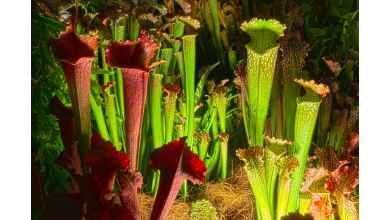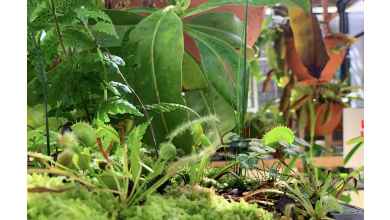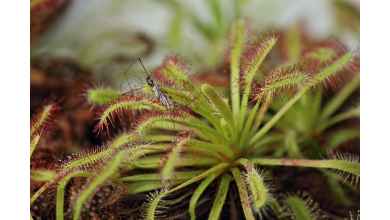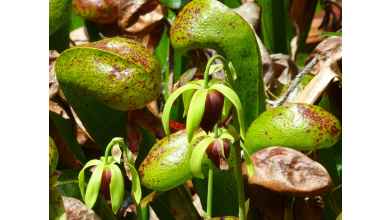All about Carnivorous Plants
Carnivorous plants are a unique type of plant that have evolved to capture and digest prey in order to obtain the nutrients they need to survive. These fascinating plants come in many different forms, from tiny, insect-eating sundews to giant, pitcher-shaped Nepenthes.
In this article, we will explore the world of carnivorous plants, examining their adaptations, biology, and diversity. We'll also discuss the best ways to care for these unusual plants, and take a look at some of the most popular species found in cultivation.
Adaptations of Carnivorous Plants
Carnivorous plants have evolved a number of adaptations that enable them to capture and digest prey. One of the most obvious adaptations is the development of specialised leaves that are modified to form traps. These traps may be shaped like pitchers, as in the case of the Nepenthes, or they may be sticky, like those of the sundews.
In addition to modified leaves, many carnivorous plants also secrete digestive enzymes that break down the proteins and other nutrients found in their prey. This allows the plants to obtain the nitrogen and other essential nutrients they need to survive in nutrient-poor environments, such as bogs and swamps.
The Biology of Carnivorous Plants
Carnivorous plants are fascinating from a biological standpoint, as they represent a unique example of convergent evolution. That is, they have evolved similar adaptations in response to similar environmental pressures, despite not being closely related.
One interesting aspect of carnivorous plant biology is their ability to sense and respond to their environment. For example, many species of pitcher plants have a specialised "lid" that can close in response to changes in temperature or humidity. This helps to prevent rainwater from diluting the digestive enzymes contained within the pitcher.
Diversity of Carnivorous Plants
Carnivorous plants come in many different shapes and sizes, from tiny bladderworts to giant Nepenthes that can reach several feet in height. Some of the most popular species for cultivation include the Venus flytrap, sundews, pitcher plants, and butterworts.
Each of these groups has its own unique adaptations and strategies for capturing prey. For example, Venus flytraps have modified leaves that snap shut when triggered by the movements of an insect, while sundews produce sticky droplets on their leaves that trap insects that come into contact with them.
Caring for Carnivorous Plants
Caring for carnivorous plants can be a bit more challenging than caring for other types of houseplants, as they require specific growing conditions in order to thrive. However, with a bit of knowledge and attention, they can be a rewarding and fascinating addition to any plant collection.
Some of the key factors to consider when caring for carnivorous plants include their soil, watering, lighting, and humidity requirements. In general, carnivorous plants prefer to be kept in a well-draining, acidic soil mix, and they should be watered with distilled water or rainwater to avoid mineral buildup. They also need plenty of bright, indirect light, and high humidity levels.
Popular Carnivorous Plants for Cultivation
There are many different species of carnivorous plants that are popular for cultivation, each with its own unique characteristics and requirements. Some of the most popular species include:
Venus Flytrap (Dionaea muscipula)
The Venus flytrap is perhaps the most iconic carnivorous plant, with its distinctive traps that snap shut when triggered by an insect. It is native to the bogs and swamps of North and South Carolina, and it requires high humidity levels and plenty of bright light in order to thrive.
Pitcher Plants (Sarracenia)
Pitcher plants are another popular group of carnivorous plants, known for their distinctive, trumpet-shaped leaves that form deep, liquid-filled pitchers. These plants are native to the wetlands of North America and require high humidity levels, bright light, and a moist, well-draining soil mix.
Sundews (Drosera)
Sundews are a group of carnivorous plants known for their sticky, glandular hairs that cover their leaves. When an insect lands on these hairs, it becomes stuck and is slowly digested by the plant. Sundews are found in a wide range of habitats around the world, from bogs and swamps to deserts and alpine regions.
Nepenthes
Nepenthes, also known as tropical pitcher plants, are a diverse group of carnivorous plants found in the tropics of Asia and Australia. These plants have a unique, cup-shaped structure called a pitcher, which is filled with digestive enzymes that break down prey. Nepenthes require high humidity levels, bright but indirect light, and a well-draining soil mix.
Butterworts (Pinguicula)
Butterworts are a group of carnivorous plants known for their flat, sticky leaves that trap insects. They are found in a variety of habitats around the world, from bogs and swamps to mountain meadows. Butterworts require bright, indirect light and a moist, well-draining soil mix.
Conclusion
Carnivorous plants are a fascinating group of plants that have evolved unique adaptations to survive in nutrient-poor environments. They come in many different shapes and sizes, from tiny sundews to giant Nepenthes, and each has its own unique strategies for capturing prey. While they can be a bit more challenging to care for than other types of houseplants, they are well worth the effort for their unique beauty and scientific intrigue.
FAQs
- Do carnivorous plants eat only insects?
- No, some species of carnivorous plants can also capture and digest small mammals, such as shrews and mice.
- Can I grow carnivorous plants in a terrarium?
- Yes, many species of carnivorous plants can be grown in a terrarium, as long as they receive adequate light and humidity.
- Are carnivorous plants dangerous to humans or pets?
- No, carnivorous plants are not dangerous to humans or pets. While their traps can be quite effective at capturing insects, they are not strong enough to harm larger animals.
- How do I feed my carnivorous plant?
- Carnivorous plants will capture and digest prey on their own, but you can also feed them small insects, such as fruit flies or crickets, if you like.
- Can carnivorous plants be grown outside?
- Yes, many species of carnivorous plants can be grown outside, as long as they are provided with the appropriate growing conditions for their specific needs.






